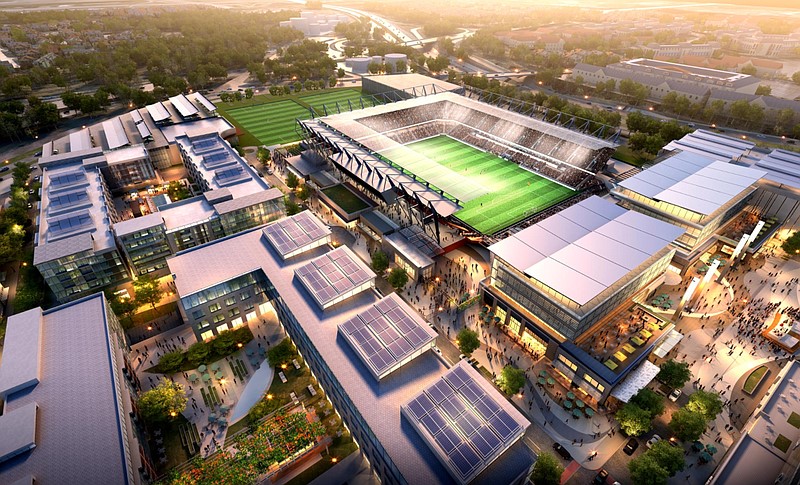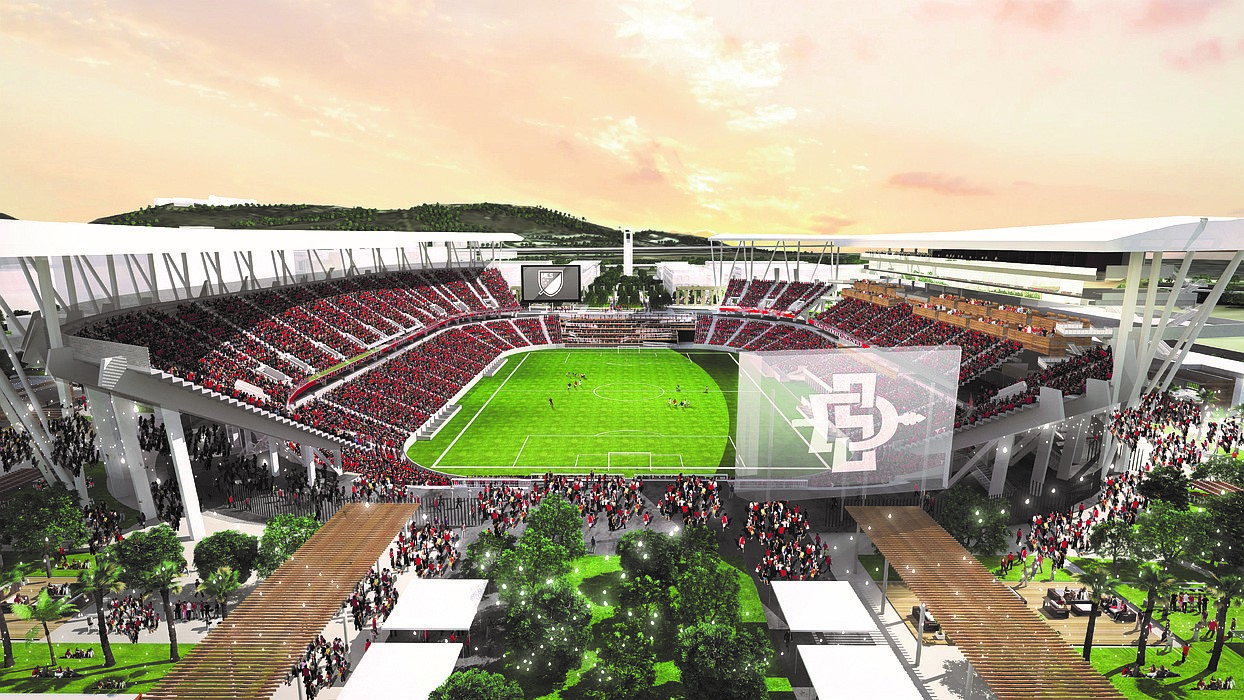What to do with the Q?
If you have lived in San Diego for any amount of time, you likely have memories from “The Q.” The building, built in 1967 and originally called Jack Murphy Stadium after a local sports writer that rallied public support for its construction, has been host to Padres, Aztec and Charger games along innumerable concerts, amateur car races and street fairs.
But, the loss of the Chargers, largely over the costs to replace the outdated venue, put the final nail in the coffin for the Mission Valley landmark. The 166-acre plot of land that the stadium sits on is one of the largest developable congruous pieces of land in Coastal California and has become a battleground for two competing projects.

The first plan was announced by a local private investment firm, FS Investors, called SoccerCity.[1] They proposed a bid to host a professional soccer team in San Diego, building a small stadium for the Major League Soccer (MLS) team and developing 4,500 housing units, 2.4 million square feet of office and a whopping 740,000 square feet dedicated to retail and entertainment.
Soccer fans in the city were hopeful that this initiative would help turn San Diego into a hotbed for the sport. But one of the stakeholders in the agreement didn’t share their enthusiasm. San Diego State University has been playing its football games in the stadium ever since it opened. The school was not happy with their options and lack of financial control under the SoccerCity proposal and so submitted a competing plan called SDSU West. This plan would include a stadium, 4,800 housing units, an SDSU extension with 1.6 million square feet of research campus and 95,000 square feet of retail.

Neither side has given up the possibility of San Diego getting another NFL team, but they do have very different approaches if it were to happen. SoccerCity would set aside a piece of land that could be used for an NFL stadium if a team were to come back while SDSU West would build their stadium in a way that allows additional seating to be added later.
Other differences include where to put the stadium (SDSU would put it on the West side of the lot while SoccerCity would locate it on the Eastern part) and who would own the parkland by the river (SDSU’s plan would leave the city as owner while SoccerCity would take ownership themselves).
What Matters Most?
There is a lot of strong viewpoints on either side of this argument so rather than getting stuck in the mud of local politics, I think it is best to talk about some of the possible implications of these developments. First, I want to take the sports teams out of the equation. There are few things economist agree on, but one is that sports teams do not add to a city’s economy.[2] They can be a moral boost for the fans in the city, but they don’t do much monetarily. Without that component we can look at how the different aspects of the plans would contribute to the city as a whole.
Housing

The biggest boost would likely come from additional housing. San Diego, like much of California, has a housing shortage. Adding new units, especially denser multifamily ones, would help make our city more affordable. But both plans have roughly the same amount of housing and, either way, 4,500 units will not do much to move the needle. According to the regional planning authority, the region will need to add around 12,000 units per year to keep up with population growth.[3]
Offices
The next big positive for the city would be more office stock. Companies grow in places with affordable offices. But the demand for office space in California has slowed a bit due to the rise of coworking, telecommuting, companies moving out of state and aggressive new construction.[4] While the SoccerCity plan would create more office space it could be argued that the SDSU West plan, which creates a biotech and research area where companies can collaborate with the University, could be more of a net benefit for the city.
Retail

Lastly, there is the retail component. SoccerCity obviously sees this as an important part of the development with over seven times more space dedicated to retail than the SDSU plan. While retail is nice for locals and tourists alike, this ignores some of the current trends. Retail, in general, is not doing so well. The rise of e-commerce and the growing desire for experience over things, especially in the younger generations, has left many malls struggling. Most new retail
is focused on being walkable from residential neighborhoods or close to a spot with a lot of foot traffic. Putting another giant mall in Mission Valley, a part of town with low population density and two other malls, might not be the greatest use of space. Even if all this retail space was utilized, it would cause a lot of extra traffic and could need a lot more parking than the 16,000 spots that the SoccerCity plan includes. By contrast, the SDSU plan has 11,500 spots set aside that would all be put underground in order to preserve the walkability of the campus.
There is a lot to think about when comparing these two competing plans. Already we have seen smear campaigns, lawsuits and hostile planning meetings leading up to the ballot and this is likely to continue. Ultimately, it is up to the public to decide in November. We all have different aspects of the plan that are more important to us but, at the very least, we owe it to ourselves and our city to stay informed about each plan and what they could mean for the future of San Diego.
References
[1] http://www.fsinvestors.com/
[2] https://www.marketplace.org/2015/03/19/business/are-pro-sports-teams-economic-winners-cities
[3] https://www.sdcaa.com/housing-supply-crisis.html
[4] https://markets.businessinsider.com/news/stocks/california-commercial-real-estate-continues-previous-trends-says-allen-matkins-ucla-anderson-forecast-california-cre-survey-1027397629
